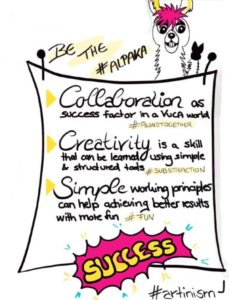After 10 years of being employed as a project manager and consultant, I’ve decided that it’s time to start-up things myself, to get my feet wet and enter the entrepreneurial world.
Before and during this transition, I naturally started looking deeper into how good work-life balances can be achieved. I began to question the status quo of work-related habits that might have a negative impact on it. Of extra and special interest to me were the ones that were an obvious nuisance but have never really been challenged due to common practices or unspoken principles.
This article outlines how slight changes in habits, a new scheduling tool and clear rules can dramatically impact your wellbeing and satisfaction in job and life. It is aimed at people working in the corporate world but also helpful for people in other environments.
The struggle of knowing what to do and how to do it right
In a hyper-connected world with way too much distraction, knowing where to start and getting the right things done has become challenging. Furthermore, the corporate world has created a meeting culture that’s robbing us of our focus time making it near impossible to get the things done properly.
It got me wondering, how are people actually getting their work done and producing high-quality outputs while still keeping a normal work-life balance? Isn’t overtime a sub-optimal scenario, possibly leading to a downward spiral of overwork?
In my time working as a consultant —which gave me a clear “external view”— and watching a variety of different companies and its people, I noticed a few common patterns:
- Tasks that needed to be done were kept in to-do lists to get them off the present mind to do them sometime in the near future
- People set up strict time blockers in their calendars in order to get these tasks done, either were lucky to be unaffected by the meeting-bonanza or just did them outside office hours
While this all seems obvious, there’s a catch and essentially a dilemma not just for you but for your company as well!
Replace to-do lists with Kanban
Busy people always have a to-do list —and who isn’t busy these days? Sometimes the items on these lists are way too many and too often decentralized over several tools. The resultant effect of this is that it makes prioritizing difficult which then leads to either doing the wrong things or effectively stop working on the list at all1. However, working on the right tasks at the right time is crucial to productivity and effectiveness.
As part of Toyota’s intent to play catchup with America’s established auto industry in the 1940s, Taiichi Ohno needed a system that could outsmart its American rivals radically. Enter Kanban, a scheduling system originally used to optimize supermarket stock, has proven to be the right tool and a game-changer for just-in-time production2.
A core principle of Kanban with its Kanban boards is to visualize your work and limit your work-in-process. This principle gives you better context and adds more clarity to your to-do’s, ensuring you are able to better prioritize what’s really due.

These boards can be as simple as 2-3 lists with tasks being entered in first, to get them out of your mind, and then moved on to the next to know what you need to work on (e.g. “To-Do”, “Today” and “Done”). Experience has shown me that your milage may vary and you may need to experiment to find the best way to work with it.
Even though it’s just a productivity tool (and there may be others that do the job just as well), it is highly effective in getting the right things done and not be startled or distracted by potential future tasks. If you’re new to Kanban (also known as “Personal Kanban”), I recommend this excellent introduction written by Thomas Oppong.
Rule #1: Visualize your work and limit your work-in-progress with a scheduling tool such as Kanban in order to know what to do and how to get the right things done.
Don’t fool yourself with mindless calendar blocking
It’s important to know what type of daily schedule resonates with you. Unless you’re a manager or higher, you’re probably a “maker” or something in between a manager and a “maker” therefore adding time blockers for tasks directly to your calendar is less than ideal. (Paul Graham explains this very well in his article on why “makers” are overthrown by the “managers”3). But since this practice is quite common, corporate meeting planners who need several attendees are either dealt a bad hand and need to accept the fact that only in a distant future are all participants available; or, they completely ignore you and your coworkers’ blocked calendar time to set up a meeting in an acceptable timeframe. For you, this means, you’ll either decline the meeting (and have a good reason to) or move your focus time to the next free slot only to find out that yet another meeting crossed plans with your focus slot essentially leading to a Tetris-like mayhem as you try to find the right time for focus work.
I’ve seen people blocking a couple of hours to multiple days, which is not only a horror to anyone planning meetings with multiple attendees but also massively delays or prevents the collaborative effects of any company. Now, there’s nothing wrong in prioritizing time to get some work done. In fact, I encourage it to get into the optimal state of focus work. Multiple studies emphasize the fact that we are not made for multitasking4 and that what Cal Newport calls “shallow work” (e.g. mails) not only decreases our energy to focus, but that this constant cognitive overload might prevent the capability almost entirely, in the long-run5. Nonetheless, basically, you have the choice between low quality work and good private life or high-quality work and bad private life. But even the latter may not end up well, as working before or after office hours isn’t for everyone and, in my opinion, may become unhealthy in the long-term. So you‘re back to square one of blocking calendar time (and fighting for it) to get work done while keeping your life.
In order to avert this conflict of preventing or delaying collaborative efforts by blocking time to do work, it’s a good start to knowing the limitations of focus work and defining clear rules with your boss. Focus time is clearly an important factor, but studies show that only about 1-4 hours of concentrated focus work is possible per day6. It’s also recommended to achieve the “maker” tasks as early as possible and schedule manager’s activities for as late in the the day as possible (if you can control it)7. I also recommend having only 1 or, at most, 2 blockers a week rather than a block of 4 hours, every day. Knowing this will help you plan your schedule better, communicate clearly and block focus time in the most efficient way possible while still respecting the meeting culture.
Rule #2: Make sure you get your fair and appropriate share of focus time agreed with your boss (1 to a maximum of 4 hours). Set blockers if needed and try to achieve your “maker” tasks as early in the day as possible.
Doing the right things right and getting even better at it = 
The quality of focus work done in blocked time slots can be improved when combined with Kanban since it not only allows focus at one task (in the slot), but will prevent focus-killing distractions by “shallow work”. This essentially trains your brain to focus and get in a state of “deep work” allowing an output with much higher quality8.
So, the visualization of your tasks in Kanban allows for better prioritisation and therefore getting the right things done, while focus time with time blockers and the right attitude gets the things done right.
Rule #3: Combine rule 1 & 2 —use Kanban during focus hours— to not only let you get your work done properly but improve the quality and quantity of your work in the long run!
Knowing how to do the right things the right way (i.e. with appropriate quality) will increase your output in quantity and quality and therefore your productivity, making pre/post office hour work no more a mandatory side-effect. Having more free time outside of work positively spirals back to a more balanced work-life and therefore a more satisfactory and meaningful life.
Go try out these rules to aim for unicorn-level productivity hack enlightenment!
What’s your experience with calendar blocking for focus time? Have you used Kanban before in these or other circumstances? Do you have a favorite productivity hack that’s missing?
- “To-Do Lists Don’t Work.”, Harvard Business Review, 24 January, 2012, https://hbr.org/2012/01/to-do-lists-dont-work ↩︎
- “Kanban.”, Wikipedia, 2018, https://en.wikipedia.org/wiki/Kanban ↩︎
- “Makers Schedule, Managers Schedule” paulgraham.com, July 2009, http://www.paulgraham.com/makersschedule.html ↩︎
- “Movie research results: Multitasking overloads the brain: The brain works most efficiently when it can focus on a single task for a longer period of time.” ScienceDaily, 25 April 2017, https://www.sciencedaily.com/releases/2017/04/170425092429.htm ↩︎
- Mark, Gloria, Victor M. Gonzales, and Justin Harris. “No Task Left Behind? Examining the Nature of Fragmented Work.” Proceedings of SIGCHI Conference on Human Factors in Computing Systems. New York: ACM, 2005. ↩︎
- “The Role of Deliberate Practice in the Acquisition of Expert Performance.”, Psychological Review 1993, Vol. 100 No. 3, 363-406 ↩︎
- “Creating Daily Flow.”: from page 177 of Maurya, Ash. Running Lean: O’Reilly, 2012 ↩︎
- “The Principle of Least Resistance”: from page 56 of Newport, Cal. Deep Work: Grand Central Publishing, 2016 ↩︎




